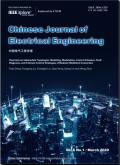Interictal Electrophysiological Source Imaging Based on Realistic Epilepsy Head Model in Presurgical Evaluation: A Prospective Study
Q1 Engineering
引用次数: 0
Abstract
Invasive techniques are becoming increasingly important in the presurgical evaluation of epilepsy. Adopting the electrophysiological source imaging (ESI) of interictal scalp electroencephalography (EEG) to localize the epileptogenic zone remains a challenge. The accuracy of the preoperative localization of the epileptogenic zone is key to curing epilepsy. The T1 MRI and the boundary element method were used to build the realistic head model. To solve the inverse problem, the distributed inverse solution and equivalent current dipole (ECD) methods were employed to locate the epileptogenic zone. Furthermore, a combination of inverse solution algorithms and Granger causality connectivity measures was evaluated. The ECD method exhibited excellent focalization in lateralization and localization, achieving a coincidence rate of 99.02% (基于真实癫痫头部模型的发作间电生理源成像在术前评估中的前瞻性研究
侵入性技术在癫痫的术前评估中变得越来越重要。采用间期头皮脑电图(EEG)的电生理源成像(ESI)来定位癫痫区仍然是一个挑战。术前癫痫区定位的准确性是治疗癫痫的关键。采用T1 MRI和边界元法建立真实头部模型。为了解决反问题,采用分布反解和等效电流偶极子(ECD)方法定位癫痫区。此外,还评估了反解算法和格兰杰因果连通性度量的组合。ECD方法在侧位和定位方面表现出优异的聚焦性,符合率达到99.02% ($p <0.05美元)的立体脑电图。ECD和定向传递函数的结合使得从颅内和头皮EEG记录中获得的信息流具有很好的匹配性。结果表明,ECD反解方法能够从无创低密度脑电图数据中提取皮层水平的放电信息。因此,术前准确定位致痫区可以减少所需的颅内电极植入次数。
本文章由计算机程序翻译,如有差异,请以英文原文为准。
求助全文
约1分钟内获得全文
求助全文
来源期刊

Chinese Journal of Electrical Engineering
Energy-Energy Engineering and Power Technology
CiteScore
7.80
自引率
0.00%
发文量
621
审稿时长
12 weeks
 求助内容:
求助内容: 应助结果提醒方式:
应助结果提醒方式:


